News
Horror Origins – The Joker and The Man Who Laughs!

Being the nightmare-creation of Bill Finger, Bob Kane, and Jerry Robinson, and pitted against the Dark Knight of Gotham, Joker (Batman # 1, 1940) quickly became the most celebrated villain in pop-culture history. Originally he was meant to be killed in the second issue, but DC noticed how well-received their newest rouge was and (wisely) extended the Clown Prince of Crime’s life. Since that day he has proven to be the Batman’s deadliest challenge.
The Joker’s crimes and atrocities are legendary and often prove to have no reason or motive behind them. He’s set off a nuke in the middle of Metropolis, personally targeted and killed members of the Bat-Family, and even threw a baby at Comm. Gordon’s wife, distracting her, and as she frantically struggled to save the child Joker shot her and left her on the floor with several stolen babies crawling over her still-warm and bleeding corpse. That’s not even the tip of the iceberg though.
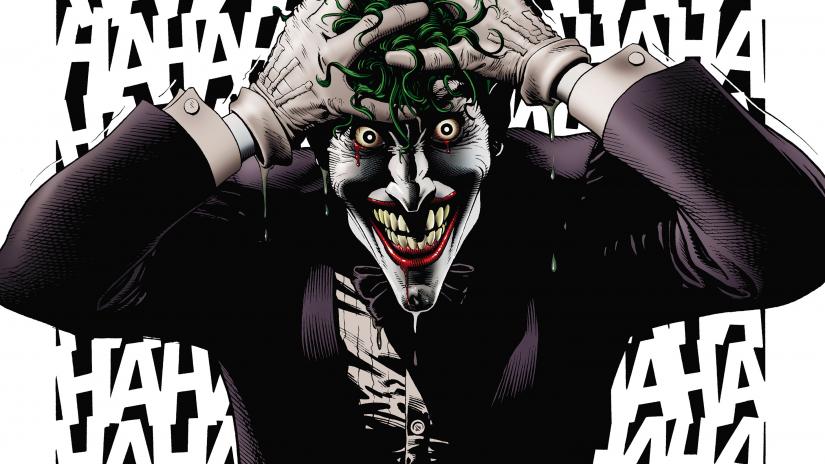
image courtesy of DC comics, artist Bill Bolland, Allan Moore, ‘The Killing Joke’
Despite his colorful attire, comical demeanor, and never-fading smile Joker is terrifying! He kills because it’s funny to him. It really just boils down to one thing – life is a sick joke and death’s the punchline. That’s his perception of reality. If you disagree then you simply don’t get the joke.
His weapon is simple – though he’s used dozens of instruments to get the point across – laughter! That alone makes him dangerous and frightening, but, of course, Joker has to take it one step further than we’d expect. He’s not above his own methods of cruelty and sadism, as, to simply shock the whole city, Joker allowed his own face to be sliced off. Then returned a year later, stole the face from lockdown at the GCPD, and wore it like a Halloween mask.

image courtesy of DC comics, ‘Death of the Family.’ written by Scott Snyder, illustrated by Greg Capulla
Because that’s the gag – no one is exempt from the horrors of reality. And he’ll wear that horror proudly for all to see.
Joker and a Dark Origin
His origins are steeped in horror history. I’m not talking about how Joker became what he is in the comics – there are too many variations to choose from there – but rather, what inspirations the creators drew from when designing the signature look of the character.
Taking inspiration largely from Paul Leni’s German expressionist silent horror, The Man Who Laughs (1928), Joker found his trademark smile from Conrad Veidt’s ghoulish disfigurement. The tragic figure of Veidt’s character, Gwynplaine, is left with a morbid smile permanently etched across his face. If that sounds familiar to you, that’s because it bears an eerie resemblance to both Jack Nicholson and Heath Ledger’s portrayal of the Joker.
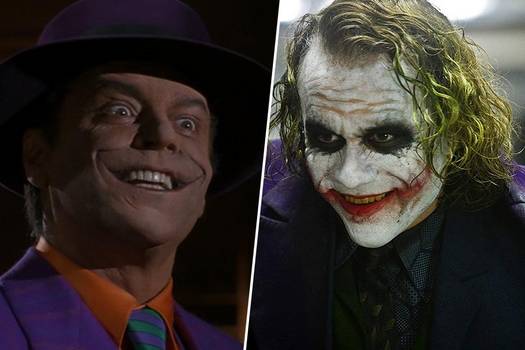
image courtesy of WB, ‘Batman’ and ‘The Dark Knight.’ Jack Nicholson, Heath Ledger
It’s a smile meant to provoke dread, discomfort, and nausea out of the viewer. Veidt’s smile is anything but the result of comedy and is a curse to him. The same can be said for Joker’s wicked grin.

image courtesy of Universal Pictures, ”The Man Who Laughs’ starring Conrad Veidt
Taking a cue from this classic tragedy, Todd Phillips, director of Joker (now in theaters) gave his titular character a similar ailment, the inability to keep from laughing during times of stress or anxiety, again, lacking humor or good-nature in Joker’s random outbursts. Like Veidt’s smile, Arthur’s (Joaquin Phoenix) laughter is a disfigurement, and a cause to pity him.
Again, as was the case with TMWL, it causes Joker to be the target of ridicule and violence.

image courtesy of WB, ‘Joker’ directed by Todd Phillips, starring Joaquin Phoenix
“Wanna Know How I Got These Scars?”
In his Oscar-winning performance in The Dark Knight, Heath Ledger’s Joker is literally scarred ear-to-ear across the mouth, leaving him with a hideous grin he could never escape.
We’re never told how he got those scars and the few times Joker offers an explanation the stories are never the same. When they happened and how are irrelevant, he just has them. And that trauma is part of who he is.

image courtesy of WB, ‘The Dark Knight’ directed by Christopher Nolan, starring Heath Ledger
The Man Who Laughs is about a boy who is purposely disfigured at an early age. His father is tried as a political prisoner and is sentenced to death by means of an iron maiden (METAL!). The boy, Gwynplaine, must go on and live with his hellish smile for the rest of his days, finding acceptance only in a traveling carnival of freaks.
Although unlike Gwynplaine, Phoenix’s Joker has no physical deformities, the two are connected in a spiritual sense. Both are results of a wicked society governed by corrupt elitists who care not a thing for those suffering in the alleyways and outskirts of high society. Both men are social outcasts, long for acceptance and are denied the comfort of any genuine affection.
They both face ridicule, mockery, and suffer from violence until in a twist of irony (or perhaps destiny) they turn violent against those who broke them down. And the smile (or the laugh) finally feels honestly earned.
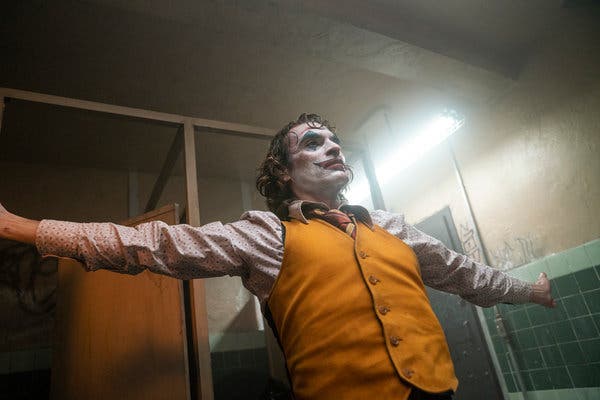
image courtesy of WB, ‘Joker’ dir. Todd Phillips, starring Joaquin Phoenix
Finally, throughout TMWL, Gwynplaine does everything he can to hide his smile, almost as if he’s trying to smother it against his arm. Shadowing this same action, Arthur, who (as aforementioned) suffers from a mental ailment that causes him to laugh uncontrollably, desperately fights against the impulse to laugh and smothers his outbursts in his arm, mirroring the very character who originally gave life to the Joker many decades ago.
Even just a curious glance at TMWL‘s trailer grants the watchful eye a view of a clown is wearing eerily similar makeup to Phoenix’s Joker (0.09).
It’s little details like that I love so much.
The Joker has enjoyed a long history of maniacal success and has been seen in many iterations. His latest incarnation is not only faithful to his comic-book history but also pays homage to the smiling man who first inspired life into our favorite clown. If you’ve not seen Joker already I highly recommend it. It is part of the horror community and is very much so a piece of our history.
'Civil War' Review: Is It Worth Watching?
Follow our new YouTube channel "Mysteries and Movies" here.

Lists
Thrills and Chills: Ranking ‘Radio Silence’ Films from Bloody Brilliant to Just Bloody
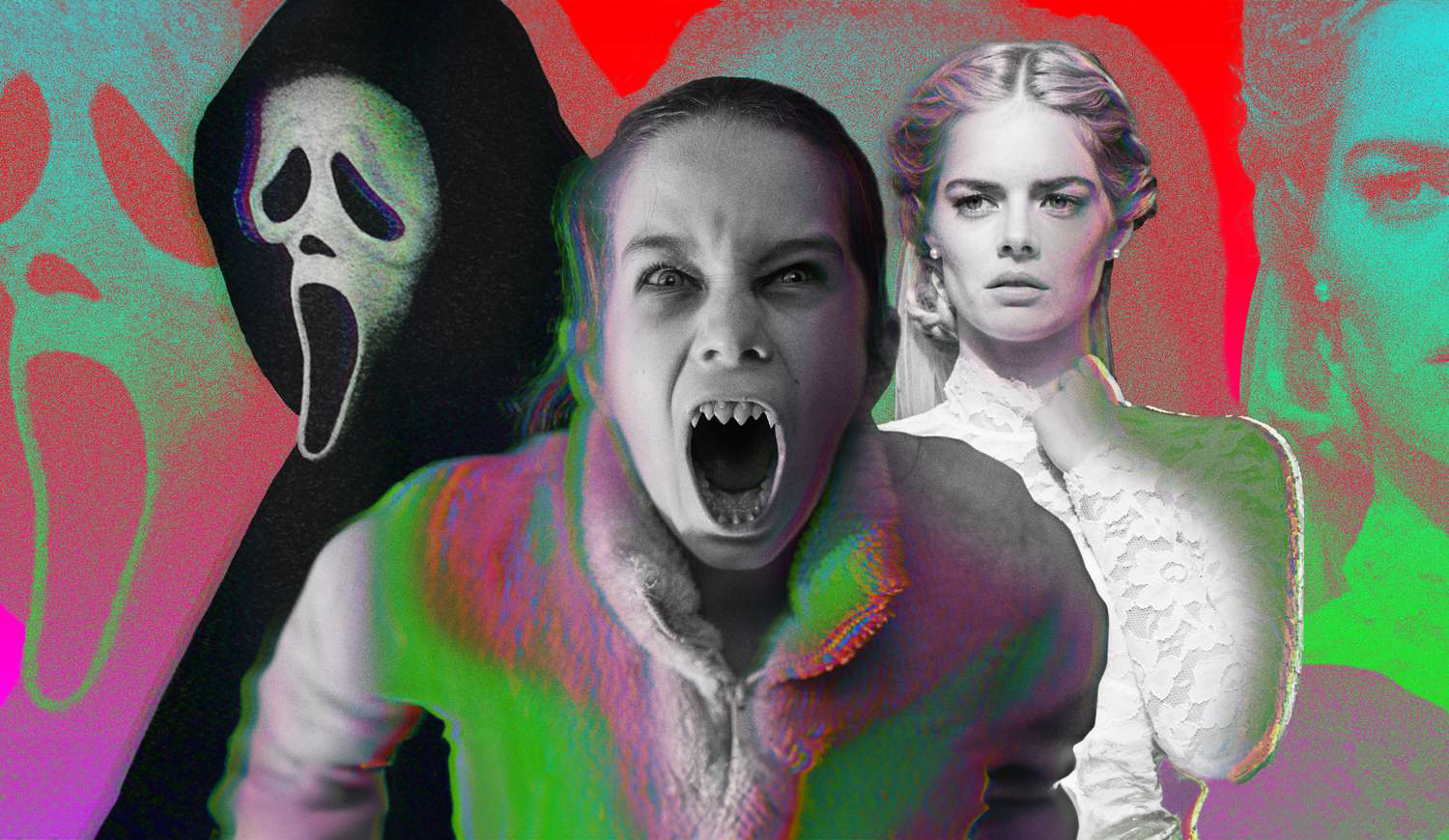
Matt Bettinelli-Olpin, Tyler Gillett, and Chad Villella are all filmmakers under the collective label called Radio Silence. Bettinelli-Olpin and Gillett are the primary directors under that moniker while Villella produces.
They have gained popularity over the past 13 years and their films have become known as having a certain Radio Silence “signature.” They are bloody, usually contain monsters, and have breakneck action sequences. Their recent film Abigail exemplifies that signature and is perhaps their best film yet. They are currently working on a reboot of John Carpenter’s Escape From New York.
We thought we would go through the list of projects they have directed and rank them from high to low. None of the movies and shorts on this list are bad, they all have their merits. These rankings from top to bottom are just ones we felt showcased their talents the best.
We didn’t include movies they produced but didn’t direct.
#1. Abigail
An update to the second film on this list, Abagail is the natural progression of Radio Silence’s love of lockdown horror. It follows in pretty much the same footsteps of Ready or Not, but manages to go one better — make it about vampires.
#2. Ready or Not
This film put Radio Silence on the map. While not as successful at the box office as some of their other films, Ready or Not proved that the team could step outside their limited anthology space and create a fun, thrilling, and bloody adventure-length film.
#3. Scream (2022)
While Scream will always be a polarizing franchise, this prequel, sequel, reboot — however you want to label it showed just how much Radio Silence knew the source material. It wasn’t lazy or cash-grabby, just a good time with legendary characters we love and new ones who grew on us.
#4 Southbound (The Way Out)
Radio Silence tosses their found footage modus operandi for this anthology film. Responsible for the bookend stories, they create a terrifying world in their segment titled The Way Out, which involves strange floating beings and some sort of time loop. It’s kind of the first time we see their work without a shaky cam. If we were to rank this entire film, it would remain at this position on the list.
#5. V/H/S (10/31/98)
The film that started it all for Radio Silence. Or should we say the segment that started it all. Even though this isn’t feature-length what they managed to do with the time they had was very good. Their chapter was titled 10/31/98, a found-footage short involving a group of friends who crash what they think is a staged exorcism only to learn not to assume things on Halloween night.
#6. Scream VI
Cranking up the action, moving to the big city and letting Ghostface use a shotgun, Scream VI turned the franchise on its head. Like their first one, this film played with canon and managed to win over a lot of fans in its direction, but alienated others for coloring too far outside the lines of Wes Craven’s beloved series. If any sequel was showing how the trope was going stale it was Scream VI, but it managed to squeeze some fresh blood out of this nearly three-decade mainstay.
#7. Devil’s Due
Fairly underrated, this, Radio Silence’s first feature-length film, is a sampler of things they took from V/H/S. It was filmed in an omnipresent found footage style, showcasing a form of possession, and features clueless men. Since this was their first bonafide major studio job it’s a wonderful touchstone to see how far they have come with their storytelling.
'Civil War' Review: Is It Worth Watching?
Follow our new YouTube channel "Mysteries and Movies" here.
News
Perhaps the Scariest, Most Disturbing Series of The Year

You may have never heard of Richard Gadd, but that will probably change after this month. His mini-series Baby Reindeer just hit Netflix and it’s a terrifying deep dive into abuse, addiction, and mental illness. What is even scarier is that it’s based on Gadd’s real-life hardships.
The crux of the story is about a man named Donny Dunn played by Gadd who wants to be a stand-up comedian, but it’s not working out so well thanks to stage fright stemming from his insecurity.
One day at his day job he meets a woman named Martha, played to unhinged perfection by Jessica Gunning, who is instantly charmed by Donny’s kindness and good looks. It doesn’t take long before she nicknames him “Baby Reindeer” and begins to relentlessly stalk him. But that is just the apex of Donny’s problems, he has his own incredibly disturbing issues.
This mini-series should come with a lot of triggers, so just be warned it is not for the faint of heart. The horrors here don’t come from blood and gore, but from physical and mental abuse that go beyond any physiological thriller you may have ever seen.
“It’s very emotionally true, obviously: I was severely stalked and severely abused,” Gadd said to People, explaining why he changed some aspects of the story. “But we wanted it to exist in the sphere of art, as well as protect the people it’s based on.”
The series has gained momentum thanks to positive word-of-mouth, and Gadd is getting used to the notoriety.
“It’s clearly struck a chord,” he told The Guardian. “I really did believe in it, but it’s taken off so quickly that I do feel a bit windswept.”
You can stream Baby Reindeer on Netflix right now.
If you or someone you know has been sexually assaulted, please contact the National Sexual Assault Hotline at 1-800-656-HOPE (4673) or go to rainn.org.
'Civil War' Review: Is It Worth Watching?
Follow our new YouTube channel "Mysteries and Movies" here.
Movies
The Original ‘Beetlejuice’ Sequel Had an Interesting Location
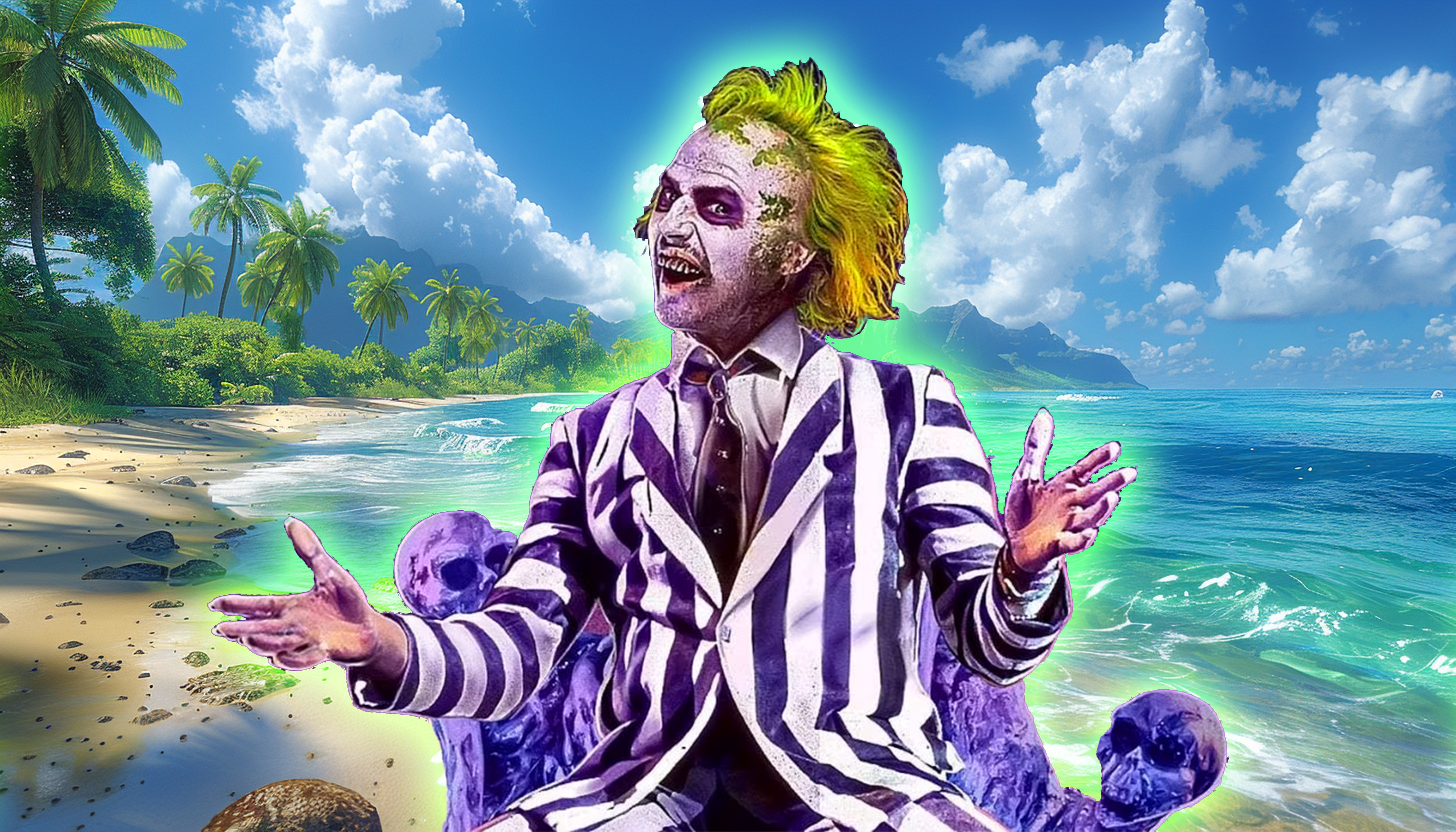
Back in the late ’80s and early ’90s sequels to hit movies weren’t as linear as they are today. It was more like “let’s re-do the situation but in a different location.” Remember Speed 2, or National Lampoon’s European Vacation? Even Aliens, as good as it is, follows a lot of the plot points of the original; people stuck on a ship, an android, a little girl in peril instead of a cat. So it makes sense that one of the most popular supernatural comedies of all time, Beetlejuice would follow the same pattern.
In 1991 Tim Burton was interested in doing a sequel to his 1988 original, it was called Beetlejuice Goes Hawaiian:
“The Deetz family moves to Hawaii to develop a resort. Construction begins, and it’s quickly discovered that the hotel will be sitting on top of an ancient burial ground. Beetlejuice comes in to save the day.”
Burton liked the script but wanted some re-writes so he asked then-hot screenwriter Daniel Waters who had just got done contributing to Heathers. He passed on the opportunity so producer David Geffen offered it to Troop Beverly Hills scribe Pamela Norris to no avail.
Eventually, Warner Bros. asked Kevin Smith to punch up Beetlejuice Goes Hawaiian, he scoffed at the idea, saying, “Didn’t we say all we needed to say in the first Beetlejuice? Must we go tropical?”
Nine years later the sequel was killed. The studio said Winona Ryder was now too old for the part and an entire re-cast needed to happen. But Burton never gave up, there were a lot of directions he wanted to take his characters, including a Disney crossover.
“We talked about lots of different things,” the director said in Entertainment Weekly. “That was early on when we were going, Beetlejuice and the Haunted Mansion, Beetlejuice Goes West, whatever. Lots of things came up.”
Fast-forward to 2011 when another script was pitched for a sequel. This time the writer of Burton’s Dark Shadows, Seth Grahame-Smith was hired and he wanted to make sure the story wasn’t a cash-grabbing remake or reboot. Four years later, in 2015, a script was approved with both Ryder and Keaton saying they would return to their respective roles. In 2017 that script was revamped and then eventually shelved in 2019.
During the time the sequel script was being tossed around in Hollywood, in 2016 an artist named Alex Murillo posted what looked like one-sheets for a Beetlejuice sequel. Although they were fabricated and had no affiliation with Warner Bros. people thought they were real.
Perhaps the virality of the artwork sparked interest in a Beetlejuice sequel once again, and finally, it was confirmed in 2022 Beetlejuice 2 had a green light from a script written by Wednesday writers Alfred Gough and Miles Millar. The star of that series Jenna Ortega signed on to the new movie with filming starting in 2023. It was also confirmed that Danny Elfman would return to do the score.
Burton and Keaton agreed that the new film titled Beetlejuice, Beetlejuice wouldn’t rely on CGI or other other forms of technology. They wanted the film to feel “handmade.” The film wrapped in November 2023.
It’s been over three decades to come up with a sequel to Beetlejuice. Hopefully, since they said aloha to Beetlejuice Goes Hawaiian there has been enough time and creativity to ensure Beetlejuice, Beetlejuice will not only honor the characters, but fans of the original.
Beetlejuice, Beetlejuice will open theatrically on September 6.
'Civil War' Review: Is It Worth Watching?
Follow our new YouTube channel "Mysteries and Movies" here.
-

 News6 days ago
News6 days agoWoman Brings Corpse Into Bank To Sign Loan Papers
-

 News7 days ago
News7 days agoHome Depot’s 12-Foot Skeleton Returns with a New Friend, Plus New Life-Size Prop from Spirit Halloween
-

 News4 days ago
News4 days agoBrad Dourif Says He’s Retiring Except For One Important Role
-

 Strange and Unusual5 days ago
Strange and Unusual5 days agoMan Arrested for Allegedly Taking a Severed Leg From Crash Site And Eating It
-

 Movies6 days ago
Movies6 days agoPart Concert, Part Horror Movie M. Night Shyamalan’s ‘Trap’ Trailer Released
-
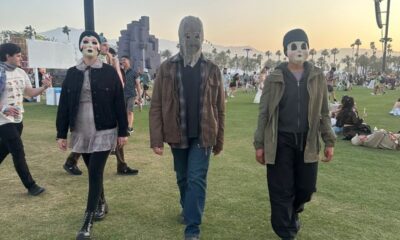
 Movies6 days ago
Movies6 days ago‘The Strangers’ Invaded Coachella in Instagramable PR Stunt
-

 Movies5 days ago
Movies5 days agoAnother Creepy Spider Movie Hits Shudder This Month
-
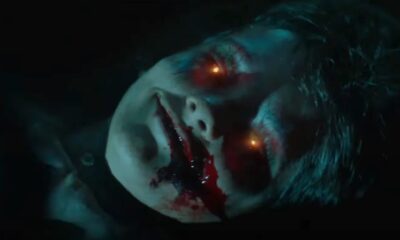
 Movies6 days ago
Movies6 days agoRenny Harlin’s Recent Horror Movie ‘Refuge’ Releasing in U.S. This Month
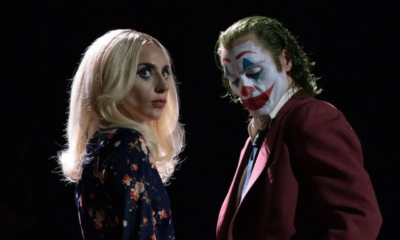

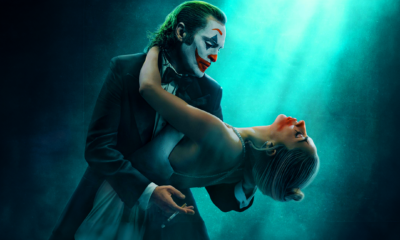



















You must be logged in to post a comment Login